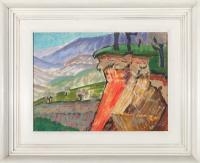Illustrated: "Bauhaus on the Swan, Elise Blumann,
an émigré artist in Western Australia", 1938-1948, Fig 88, page 106.
With her husband and two sons, Elise Blumann arrived in Perth in 1938,
settling within walking distance of the Swan River. Surrounded by this new
landscape, she began painting the distinctive Melaleucas and the river in a
style that was unfamiliar and, at times, unsettling to Australian audiences
of the period. Her approach, shaped by European modernism, stood in stark
contrast to the traditional techniques then dominating the local art scene.
...
When her work was first exhibited at the Newspaper House Art Gallery in
1944, alongside the sculptures of Dr. Marion Radcliffe Taylor, it generated
a degree of confusion and curiosity. In his review for
The West Australian
, titled An Unusual Exhibition, critic George Pitt Morison wrote:
"Her landscapes are rather hard to understand. One is so used to the
old traditions that any departure is viewed with disfavour; on closer
study, however, one is conscious of Elise Burleigh’s motive. She has
eliminated all unnecessary detail and accentuated the theme she wished
to express."
Blumann’s paintings embraced a flattened, two-dimensional quality. Her
compositions centred firmly on the subject, which became the focal point of
the work. In “Red Cliffs”, a subtle panoramic effect is created
through sparse, undulating hills and a softly muted sky that balances the
composition without distracting from the dramatic cliff face at its core.
Her brushstrokes are bold and decisive, with strong foreground colours that
gradually lighten as the landscape recedes—revealing depth without
sacrificing the strength of her mark-making.
By 1947, Australian audiences remained largely unacquainted with the
modernist movements sweeping across Europe. Blumann’s work was met with a
degree of hesitation, even among seasoned critics. Yet, over time, her
distinctive vision found recognition. Today, her work is held in numerous
institutional and private collections across Australia, a testament to her
role in shaping the trajectory of modern art in this country.
Read more


